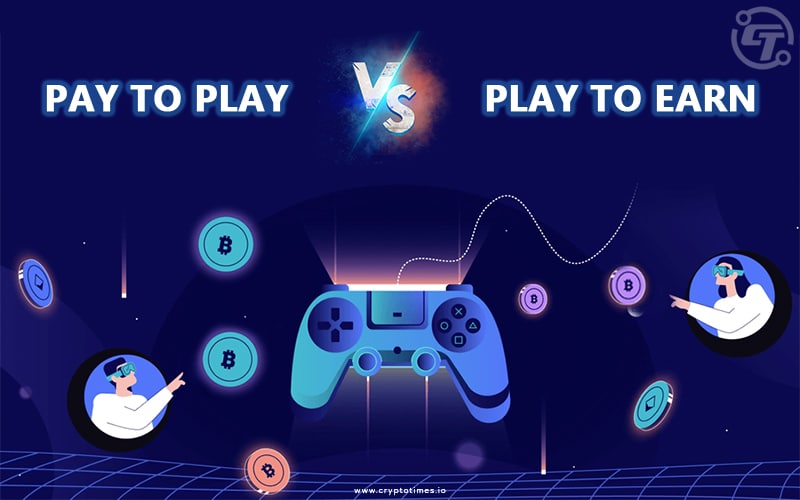Despite the millions of people who play online games, only a few are aware of emerging decentralized gaming concepts that can actually generate a new stream of income. The pay-to-play business, a cornerstone of online gaming, may give way to the play-to-earn paradigm to help you monetize your gaming skills.
In this article, we will explain the concept of “Pay to Play” and also how the Play to Earn business model works. Continue reading to find out how this Web3 idea is connected to NFTs, the Metaverse, and digital currencies. Let’s understand what implications this has for the world of online gaming.
The Definition Of “Pay To Play”
Even in the realm of digital entertainment, the pay to play paradigm is the norm. Video games that follow the pay-to-play business model are similar to freemium games, with the exception that players must spend real money to get access to certain in-game content.
Most gambling games need registration and a real-money payment before they can be played, thus the notion of paying to access games is straightforward for the ordinary online casino player. For games that don’t include money, however, this approach is best applied to traditional MMORPGs like World of Warcraft and Eve Online.
The free-to-play model is the antithesis of the pay-to-play model, since users may get access to the game, play it, and enjoy the vast majority of its content without spending any money. There is always an exclusive section of the narrative for those who are ready to pay more to access more features. Although most online players prefer F2P games, the popularity of Pay to Play gaming is growing among serious gamers throughout the globe.
Monthly subscription fees are the foundation of the pay-to-play business model. It’s easy to understand since it functions similarly to online gaming subscriptions. Through a subscription-based gaming model, players pay to get access to a variety of in-game features.
How Do P2P Games Work?
The vast majority of games that require payment to play are massively multiplayer online role-playing games (MMORPGs). Popular pay-to-play games include World of Warcraft, Eve Online, and RuneScape, which are available for both free and paid play.
How does it all function, then? A gamer essentially pays the game’s developer a monthly fee to keep their account active. The game will be inaccessible until the charge is paid.
Game developers have come to realize in recent years that this strategy, although lucrative on its own, is most effective when coupled with freemium models. Among the many examples of a hybrid paradigm, the fantasy video game RuneScape stands out.
The play-to-earn concept may alter the status quo by returning revenue from gaming corporations to the gamers themselves.
The Definition Of Play To Earn
The play-to-earn concept is based on empowering gamers monetarily while making the gameplay interesting with exciting crypto rewards. There are a variety of ways players can earn rewards via different activities, including regular gameplay, participation in special events, and completing in-game activities.
Participants may, in essence, win real money by taking part in the game. Play to Earn games also involve selling and collecting in-game items such as NFTs and cryptocurrencies
How Do P2E Games Function?
To provide a satisfactory response to this inquiry, we may need to go into the topic of the three primary components required for play-to-earn games to function.
- NFT – the exclusive tokens available for exchange and sale.
- The blockchain looks after all cryptocurrency transactions.
- Play-to-earn games are played in Web3 as well as the Metaverse.
Why Do Non-Fungible Tokens Matter in Play-to-Earn Crypto games?
In any case, NFTs have become in-game elements for the play-to-earn model’s inner workings. The strategy assumes that users will engage with the game, amass in-game assets, and then trade those assets for real-world currency. One of the first prominent instances of P2E is the game, Axie Infinity.
Players in Axies get to use special potions to create small creatures called “Axies.” Each Axie represents a separate NFT that may be used to create the elixir at a later time. But the real hook is the potion: it’s not just any potion, it’s a cryptocurrency that can be traded for real money after you’ve collected enough of them in-game.
Since they are NFTs, they may be bought and sold using Ethereum or any other cryptocurrency. Check out the value of Play-to-Earn tokens if you don’t trust us and think NFTs are nothing more than internet mumbo jumbo. In-game non-fungible tokens, or NFTs, known as Axie Infinity tokens, will appear. Earned in-game, they may be traded for other cryptocurrencies like Bitcoin which you can easily trade from Bitcoin Rush.
Conclusions:
There have been discussions about bridging the gap between the NFT and crypto communities and the online casino industry. These emerging gaming concepts might lead to a model in which users can gamble in a virtual environment and earn NFTs or cryptocurrencies that can be converted into fiat cash. Thus, a decentralized approach to gaming can truly empower gamers across the globe.
The most likely route is the Metaverse gambling sector, which might encourage a new generation of gamers to adopt crypto and NFTs for their gaming needs.
One of the most visited Metaverses, Decentraland, is reportedly in the works of building a casino. Customers may wager their crypto at these casinos in the hopes of winning NFTs. There would be a lot more advancements in the years ahead, as the gaming industry has been rapidly evolving, attracting more and more gamers.
Also Read: Game Developers and Gamers Embracing In-Game NFTs: A Measured Response






